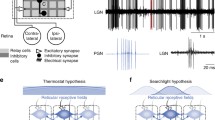Summary
Visual receptive field properties of neurons in the region of the thalamic internal medullary lamina were studied in alert cats while they fixated in various directions. In slightly more than 50% of the cells, the responsiveness of the cells was found to depend on the location of the stimulus with respect to the head-body axis (stimulus absolute position). A cell could ignore a stimulus outside its absolute field even if it was well placed within its receptive field.
Three types of neurons were distinguished. Neurons with small central receptive fields were tonically activated when the animal fixated the stimulus in one half of the screen (usually contralateral). The firing rate of these cells was related to the stimulus absolute position measured along a preferred axis. Similarly, neurons with large receptive fields fired as a function of stimulus absolute position but stimulus fixation was not required. Neurons with eccentric fields responded to stimuli located in a target area defined in head-body coordinates. Such cells gave presaccadic bursts with eye movements terminating in the target area.
The conclusion proposed is that neurons exist which code visual spatial information in a non-retinal frame of reference. This coding takes place at the time of stimulus presentation. Its role may be seen in the initiation of visually guided movements.
Similar content being viewed by others
References
Hallet PE, Lightstone AD (1976) Saccadic eye movements toward stimuli triggered by prior saccades. Vis Res 16: 99–106
Jacobs GH (1969) Receptive fields in visual systems. Brain Res 14: 553–573
Kase M, Noda H, Suzuki DA, Miller DC (1979) Target velocity signals of visual tracking in vermal Purkinje cells of the monkey. Science 205: 717–720
Lanman J, Bizzi E, Allum J (1978) The coordination of eye and head movement during smooth pursuit. Brain Res 153: 39–53
Magnin M, Kennedy H (1979) Anatomical evidence of a third ascending vestibular pathway involving the ventral lateral geniculate nucleus and the intralaminar nuclei of the cat. Brain Res 171: 523–529
Maldonado H, Joseph J-P, Schlag J (in press) Types of eye movements evoked by thalamic microstimulation in the alert cat. Exp Neurol
Mays L, Sparks D (1979) Interaction of saccades induced by visual stimuli and electrical stimulation of the superior colliculus. Soc Neurosci Abstr 5: 377
Mcllwain JT (1976) Large receptive fields and spatial transformations in the visual system. Int Rev Physiol 10: 223–248
Miles FA, Fuller JH (1975) Visual tracking and the primate flocculus. Science 189: 1000–1002
Mountcastle VB, Lynch JC, Georgopoulos A, Sakata H, Acuna C (1975) Posterior parietal association cortex of the monkey. Command functions for operation within extrapersonal space. J Neurophysiol 38: 871–908
Peck CK, Schlag-Rey M, Schlag J (in press) Visuo-oculomotor properties of cells in the superior colliculus of the alert cat. J Comp Neurol
Prablanc C, Echallier JE, Jeannerod M, Komilis E (1979) Optimal response of eye and hand motor systems in pointing at a visual target. II. Static and dynamic visual cues in the control of hand movement. Biol Cybern 35: 183–187
Robinson DA (1975) Oculomotor control signals. In: Lennerstrand G, Bach-y-Rita P (eds) Basic mechanisms of ocular motility and their clinical implications. Pergamon Press, Oxford, pp 337–374
Robinson DL, Goldberg ME, Stanton GB (1978) Parietal association cortex in the primate: sensory mechanisms and behavioral modulations. J Neurophysiol 41: 910–932
Schlag J, Lehtinen I, Schlag-Rey M (1974) Neuronal activity before and during eye movements in thalamic internal medullary lamina of the cat. J Neurophysiol 37: 982–995
Schlag J, Schlag-Rey M (1977) Visuomotor properties of cells in cat thalamic internal medullary lamina. In: Baker R, Berthoz A (eds) Control of gaze by brain stem neurons. Elsevier, Amsterdam, pp 453–462
Schlag-Rey M, Schlag J (1977) Visual and presaccadic neuronal activity in thalamic internal medullary lamina of cat: a study of targeting. J Neurophysiol 40: 156–173
Sparks DL, Mays LE, Pollack JG (1977) Saccade-related unit activity in the monkey superior colliculus. In: Baker R, Berthoz A (eds) Control of gaze by brain stem neurons. Elsevier, Amsterdam, pp 437–462
Wiersma CAG (1966) Integration in the visual pathway of Crustacea. In: Wiersma CAG (ed) Nervous and hormonal mechanisms of integration. University of Chicago Press, Chicago (Symp Soc Exp Biol vol 20) pp 151–177
Author information
Authors and Affiliations
Rights and permissions
About this article
Cite this article
Schlag, J., Schlag-Rey, M., Peck, C.K. et al. Visual responses of thalamic neurons depending on the direction of gaze and the position of targets in space. Exp Brain Res 40, 170–184 (1980). https://doi.org/10.1007/BF00237535
Received:
Published:
Issue Date:
DOI: https://doi.org/10.1007/BF00237535




